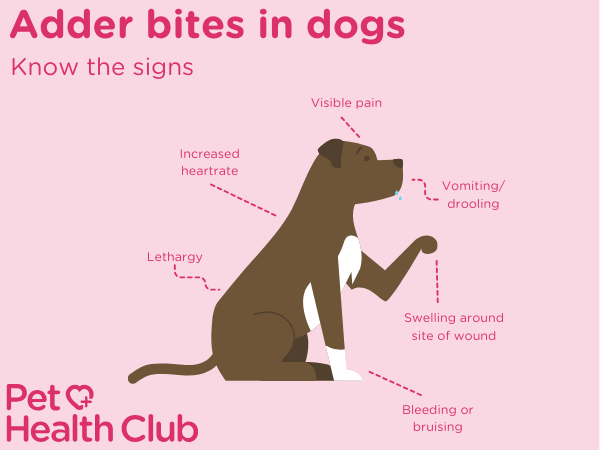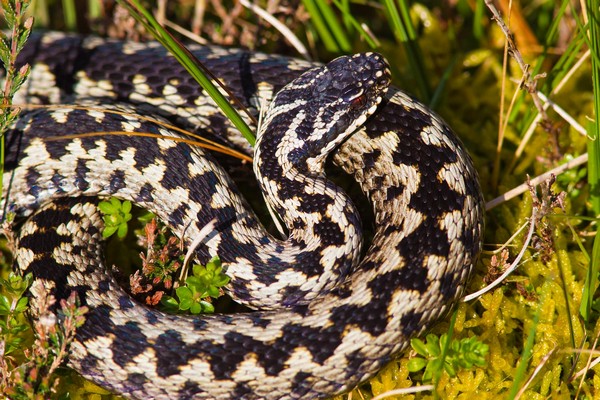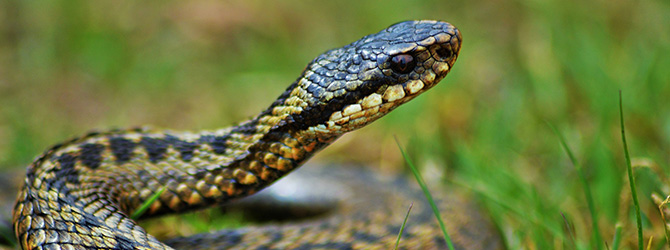Adder bites in dogs
First Published: 26/03/2019
Last Updated: 27/03/2024
Adders are the only venomous snakes in the UK and are generally active from early spring to October, when they aren’t in hibernation. They often live in sand dunes, hillsides, moors, and woodlands and are most likely to bite dogs between April and July, especially in the late afternoon - around 3 to 4 pm.
If you suspect an adder has bitten your dog, immediately check for two small puncture wounds, swelling, or redness in the area — these are common signs of an adder bite.
It's important to keep your dog calm and as still as possible to slow the venom spreading through their body. Contact your vet immediately for advice.
How do I know if an adder’s bitten my dog?
Each dog can react differently to an adder bite, so the type and severity of symptoms can vary. Swelling and pain are typically the most immediate and noticeable signs.
Two small puncture wounds
These are the most telltale signs. They're where the adder's fangs penetrate the skin. Depending on your dog's fur and the location of the bite, these might be hard to spot.
Swelling
The area around the bite can swell quite a bit. This swelling can appear quickly and might spread beyond the immediate area of the bite.
Redness and bruising
The skin around the bite may become red and bruised as the venom affects the surrounding tissue.
Bleeding
While not always present, there might be a bit of bleeding from the puncture sites.
Always pay close attention to your dog on walks, especially off-lead. This can help you spot when your dog gets hurt, especially if they yelp or jump away from something you can’t see.
Adder bite dog symptoms
If you don’t see the incident or notice any immediate distress from your dog, you may spot the following symptoms later on:
- Severe swelling around the site of the wound
- Visible pain, such as limping or holding up a leg
- Bleeding or bruising
- Inflammation from the spread of venom
- Increased heart rate or quickened breathing
- Drooling
- Vomiting
- Lethargy or general weakness

What should I do if my dog’s been bitten by an adder?
Contact your vet as soon as possible. Remain calm, and remember that most dogs bitten by adders fully recover within five days.
If your dog is yelping or frightened, don’t panic. Dogs can pick up on your emotions, so panicking will make them even more distressed.
If you can, carry them home or back to the car. The less your dog moves, the slower the venom will travel through their bloodstream. This will also minimise the risk of movement-related pain, especially if your dog has been bitten on the paw or leg.
Treatment for adder bites in dogs
If an adder has bitten your dog, it is important to get it to the vet as quickly as possible. The vet's treatment will aim to manage the symptoms and support your dog through recovery.
Here's what veterinary treatment for an adder bite on a dog typically involves:
Initial assessment
Examination
The vet will examine your dog to assess the severity of the bite, looking for swelling, pain, and the general reaction to the venom.
History
They'll ask about the circumstances of the bite to gauge the likely amount of venom injected and the time passed since the bite.
Treatment options
Pain relief
The vet is likely to administer pain relief medication. This is often the first step, as adder bites can be very painful.
Anti-inflammatory medication
Anti-inflammatory drugs will be given to reduce swelling and inflammation.
Fluid therapy
If your dog shows signs of shock or severe systemic reaction to the bite, intravenous fluids might be administered to support organ function, blood pressure and hydration.
Antivenom
In severe cases, where the reaction to the bite is intense, the vet may administer antivenom if they have access to it. This is not always necessary and is based on the dog's reaction to the bite. It's also important to note that antivenom can sometimes cause allergic reactions, so it's only given if definitely needed.
Monitoring
Your vet will want to monitor your dog for a period after the bite to ensure no complications or worsening of symptoms. Depending on the severity, this might mean staying at the vet for a few hours or overnight.
Home care
After the initial treatment, your vet will give instructions for caring for your dog at home. This might include keeping the bite area clean, administering medications, and limiting your dog's activity.
Prevention of secondary infections
Given the nature of snake bites, there's a risk of bacterial infection at the wound site. Your vet might prescribe antibiotics to prevent this.
Recovery
Recovery from an adder bite can vary. Most dogs begin to show improvement within a few days, but it might take a week or more for all symptoms to resolve fully. Your vet may request a follow-up visit to check your dog's recovery and manage any ongoing symptoms.
Are there any studies into adder bites in dogs?
In this study, looking at cases reported to the Veterinary Poisons Information Service, most adder bites on dogs happened between April and July, especially around 3 to 4 pm. These incidents were most common in the south-east of England. The usual signs included swelling of the face and limbs, alongside symptoms like lethargy, depression, overheating, and rapid heartbeat. Around two-thirds of the affected dogs showed both whole-body and localised symptoms. Symptoms typically started within two hours of the bite, but most dogs improved within five days. Antivenom, used in over half of the cases, seemed to halve the time dogs suffered from swelling, cutting it down from an average of 94 hours to just 47. While adder bites often led to significant health issues — with 97% of the bitten dogs showing symptoms — the risk of death was quite low, with only 4.6% fatal.
This study reviewed cases of dogs bitten by adders and examined whether treatment with corticosteroids—a type of anti-inflammatory medication—alongside standard care improved outcomes compared to standard care alone. It found there isn't enough evidence to conclude whether giving corticosteroids is helpful or not for dogs bitten by adders. While they might benefit dogs reacting negatively to antivenom, there's no solid proof to justify their use to treat adder bites and more research is needed.
Why would an adder bite my dog?
Adders aren't naturally aggressive towards dogs or humans. They much prefer a quiet life, away from the hustle and bustle. If your dog does get bitten by an adder, it's usually down to:
Self-defence
If an adder feels trapped or threatened, it might bite to defend itself. Dogs are naturally curious and might sniff or poke around in bushes or under rocks where adders hide, especially in their natural habitats.
Accidental encounters
Your dog might accidentally step on or disturb an adder while exploring. Since adders like to bask in sunny spots, a dog can catch them off guard, leading to a defensive bite.
Protecting territory
During the breeding season, adders might be more territorial and likely to bite if they feel their space is invaded.

An adder bite is more about the snake feeling cornered or surprised rather than seeking out your dog. That's why it's good practice to keep an eye on your dog and maybe keep them on a lead in areas where adders are known to live, especially during the warmer months when adders are most active.
How can I prevent my dog from getting bitten by an adder?
Keep to the path
Try to stick to clear paths when walking in areas known for adders, such as heathlands, moorlands, grassy areas, or woodlands. This reduces the chances of accidentally disturbing an adder.
Use a lead
In high-risk areas, keeping your dog on a lead can prevent them from poking around underbrush or heather where adders may be hiding.
Stay vigilant in warm weather
Adders are more active in the warmer months, especially on sunny days when they go to bask. Be extra cautious during these times.
Educate yourself
Knowing what adders look like and their preferred habitats can help you avoid these areas or be more alert when you're in them.
Avoid known adder habitats
If possible, avoid walking your dog in areas with a high population of adders, especially during their active season in spring and summer.
Check your garden
If you live in an area with adders, ensure your garden doesn't offer attractive hiding spots for snakes. Keep grass short and clear away debris or piles of rocks where snakes might seek shelter.
Supervise your dog
Always keep an eye on your dog when they're outdoors, especially if you're in an area where adders could be present.
Can an adder bite kill my dog?
The thought of your dog being bitten by an adder can be worrying. While it's true that an adder's venom is toxic, it's quite rare for a bite to be fatal to dogs. The severity of an adder bite can vary depending on several factors, like the amount of venom injected, the location of the bite, and the size and health of your dog. Generally, smaller dogs or those with health issues might be more at risk of severe reactions.
However, the majority of dogs recover from adder bites, especially with quick and proper treatment. The key is to get your dog to the vet as soon as possible.
What do adders look like?

Image of European Adder - © Natural England. Photo by Allan Drewitt Source
Adders, also known as European vipers, have some pretty distinctive features that can help you spot one. Here's what to look out for:
Colour and pattern
Adders have a unique zigzag pattern running down their back, varying in colour from dark brown to black. Their general body colour can be grey, reddish, or even greenish.
Size
They're not huge snakes. Adders are usually about 60-80cm long, about the length of a guitar. Males are typically smaller and more slender than females.
Head shape
Adders have a distinct V-shaped marking on their heads, which are somewhat triangular, a bit like the shape of a kite. This shape is a common feature of many venomous snakes and helps them stand out from other non-venomous snakes in the UK.
Eyes
Their eyes are red with a vertical pupil, which gives them a bit of a spooky look if you get close enough to notice.
Remember, adders are protected under UK law, so if you see one, it's best to admire it from a distance and not disturb it.
What other snakes live in the UK?
Besides the adder, you might encounter two other snakes in the UK. These are the grass snake and the smooth snake, and both are non-venomous.
Grass snake
Grass snakes are usually green or brown, with a distinctive yellow and black collar around their necks. They're quite large—the biggest snake in the UK—and can grow up to 150 cm long.
They love wetland areas but can also be found in gardens, especially if you have a pond. They're excellent swimmers.
Their diet mainly consists of amphibians like frogs and toads. They are not venomous and pose no threat to humans or dogs.
Smooth snake
Smooth snakes are smaller and more slender than adders or grass snakes, growing to around 70cm. They are grey or brown in colour and have a unique pattern of black spots down their back, but they lack the distinct zigzag pattern of the adder.
They prefer smooth sandy areas and are often found in heathlands. Smooth sandy areas are rare and protected in the UK.
They feed on small mammals, birds, lizards, and snakes. Like the grass snake, they're non-venomous and harmless to humans and dogs.
Remember, all these snakes, including the adder, are protected under UK law, meaning harming or disturbing them is illegal. If you spot a snake in the wild, leave it be.
Need more info on adder bites on dogs?
Contact your vet immediately if you suspect an adder has bitten your dog.
You can find your nearest vet using our find a vet page, or speak to a vet online using online vets.



